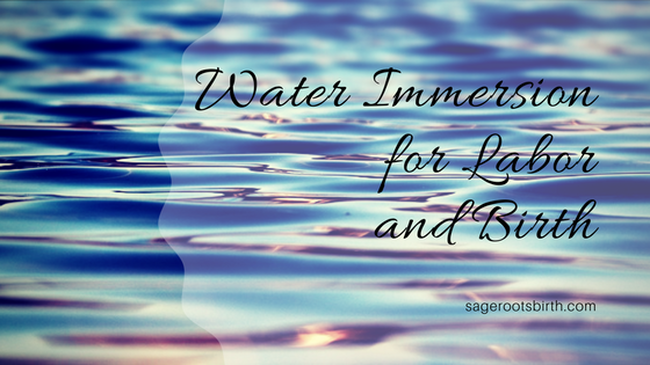|
Over the last 30 years, water immersion for labor and birth has been growing in popularity as a means of reducing pain and stress during childbirth. The term “water immersion” is usually reserved to mean laboring in water during the first stage of labor and getting out of the water for the second and third stages of labor. The term “waterbirth” better describes what happens when the birthing person remains in the water during the second stage of birth, when baby is born. In this article, the two will be addressed as one. Keep in mind, however, that when and how much you use any time of water during labor and birth is up to you and should be talked over with your care provider. What are the benefits of water immersion during labor and/or birth? For the birthing person, water immersion during labor and/or birth has shown to have numerous benefits. Warm water causes the perineum to become more elastic and relaxed, so it makes sense that waterbirth is associated with lower episiotomy rates and high rates of intact perineum. Immersion in warm water is also soothing, comforting, an relaxing in multiple ways. This allows the mother’s body to produce more endorphins, the body’s natural pain-inhibitors. It also helps lower high blood pressures causes by anxiety. The physical relaxation that is promoted by water immersion helps the mother relax mentally, as well. Immersion in water also provides a greater sense of privacy, which can reduce inhibitions, anxiety, and fears. So, it only makes sense there are higher rates of women using less medicine for pain relief when water immersion or waterbirth takes place. Finally, the buoyancy effect of water lessons the mother’s body weight, allowing free movement and new positioning which aids the progress of labor. Buoyancy also promotes more efficient uterine contractions and improved blood circulation which results in better oxygenation of the uterine muscles, less pain for the mother, and more oxygen for the baby. For baby the benefits are less clear. The idea is that waterbirth provides an environment similar to the amniotic sac and is therefore gentler on baby. Water immersion eases the stress of birth on the mother, which in turn reduces the stress on baby. This is thought to increase the reassurance and sense of security in baby even after birth. What are the potential risks of water immersion and/or waterbirth? The risks of water immersion and waterbirth for women already experiencing low-risk pregnancies are also low. According to the Royal College of Obstetrician and Gynecologists, there is a theoretical risk of water embolism. This is when water enters the mother’s blood stream. There is also a slight risk of baby aspirating on water should baby be in distress or the umbilical cord becomes kinked or twisted causing the baby to gasp for air. However, the research done thus far shows the reports of breathing problems or infections in infants after a waterbirth to be rare with fewer or equal NICU admission rates compared to babies born on land. Normally, babies do not inhale until they are exposed to air. They continue to receive oxygen through he umbilical cord until they start to breath on their own or the cord is cut. The final potential risk is the umbilical cord tearing or snapping as the baby is brought to the surface of the water. This risk is greatly lowered by simply using caution when bringing baby to the mother’s chest. There are a few cases when you should discuss the risks of immersion and waterbirth more thoroughly with your care provider. If you have herpes, your baby is breech, you have been diagnosed with excessive bleeding or maternal infection, you are having multiples, preterm labor is expected, there is severe meconium, you have toxemia or preeclampsia you should talk to your doctor or midwife about the additional risks involved before making your decision. Not all of these factors will automatically eliminate water immersion or waterbirth. However, they do pose increased risks that need to be considered. When can a laboring woman get into the water? After benefits and risks, this is the most common question regarding water immersion and water birth. The birthing person should be encouraged to use the labor pool or tub whenever they want. However, if submerged in water in early labor, before contractions are strong and close together, the water may relax her enough to slow or stop labor altogether. Some practitioners limit the use of water immersion until labor patterns are established and the cervix is dilated to at least 5 centimeters. Yet, some mothers find a bath in early labor useful to both calm them and help determine if labor has actually begun. If contractions are strong and regular, no matter how dilate the cervix is, a bath might help the mother to relax enough to facilitate dilation. It may, therefore, be wise to try water immersion in a “trail of water” for at least an hour and allow the mother to judge its effectiveness. Midwives have reported that for some women immersion in water has speed up their labor rather than slowed it down. The first hour of immersion is usually the best for both pain relieve and dilation. No matter when you decide is the right time for you, remember that movement is still important. You can still use many of the same positions in a tub or pool as you would on dry land. Try kneeling, squatting, sitting, laying back, and so on. Be sure to utilize the buoyancy that eases movement by swaying, bouncing, wiggling, or whatever movement feels best. Still change positions every 20-30 minutes. It is also a good idea that after 90 minutes of immersion to get out and stand or walk for 20 minutes or so before getting back in. This is an excellent time to empty your bladder which allows labor to process as well. Finally, remember to continue to eat and drink to hunger and thirst even when you’re in the water. Labor takes just as much energy in water as on land. References:
1 Comment
6/23/2020 09:10:27 am
I like what you said about using water birth since the perineum becomes more relaxed. My wife and I are expecting our first child soon, and she wants to be comfortable. I'll share this information with her so that she can look into her options for professionals who can help her with this.
Reply
Leave a Reply. |
LauraI'm the owner of Sage Roots. Woman, wife, mother, doula, writer, bookworm, hiker, gamer, and Christian. Categories
All
Archives
September 2022
|
Services |
Company |
|



